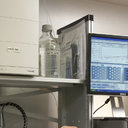Toxic effects of cadmium on tall fescue and different responses of the photosynthetic activities in the photosystem electron donor and acceptor sides.
Atslēgvārdi
Abstrakts
Tall fescue (Festuca arundinacea Schreb) is a turf grass species which is widely used for rhizoremediation of organic contaminants and shows notable prospects in heavy metal phytoremediation. In this study, different concentrations of cadmium ion (Cd2+) were applied to study toxic effects of Cd2+ and responses of tall fescue by soilless culture. Tall fescue showed comparable high tolerance to Cd2+ as Indian mustard (Brassica juncea L.). Additionally, the treatment with high concentration of Cd2+ leaded to decreased chlorophyll contents, production of reactive oxygen species (ROS) and lipid peroxidation, as well as damage of cell membrane, necrosis and apoptosis in tall fescue roots, and toxicity of Cd2+ on physiologic properties of tall fescue has been well discussed. Moreover, in photosystem II electron donor side, electron transport from oxygen evolution complex (OEC) to Yz residue of D1 protein was inhibited under high Cd2+ treatments, which may be due to the Cd2+ induced ROS production and the replacement of Ca2+ in the core of OEC. In electron acceptor side, electron transport efficiency from quinone B to photosystem I acceptors increased under high Cd2+ treatments, which may be an important response for plants against Cd2+ toxicity and its mechanism needs our further study.




